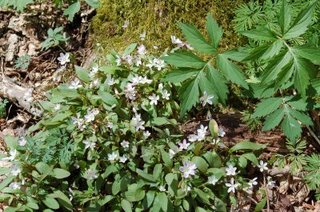
The spring beauty (Claytonia virginica) on Droop Mountain is bloomed out for this year, but at the headwaters of the Williams (about 800 feet higher than Droop), it's still in abundant flower. It's quite lovely, and has the interesting feature of having different chromosome numbers in different parts of the plant.
The day I unloaded the moving van at my house in 1999, a friend pointed out this plant in my yard, and observed to her 12-year-old son that it was edible. He asked her why he should remember that, and she said, "Because someday you may be hungry." Although she's only about 40, she grew up in the old-time way in Pocahontas County, without electricity or "modern conveniences." If her grandparents didn't grow it or make it, she did without it. To this day, she gathers and sells ramps, ginseng, Indian pipe, Podophylum, and anything else that grows in the woods that can bring in a dollar.
As a folklore informant, she has excellent credentials. However, I'm not about to cook up a mess of Claytonia and eat it on her advice, even though I have eaten other members of the Portulacaceae (purslane family). For one thing, she consistently called it "crowfoot." There is a genus of spring flowers called crowfoot (Ranunculus). Now, the buttercup family (Ranunculaceae) has some seriously poisonous members, and even though I think she has correctly identified an edible plant, and incorrectly remembered the name, I'm not going to experiment without some further confirmation, especially since I'm not going hungry.
Many of my mother's wildflower identifications were wrong. Sumac, ironweed, dock--she put all these names on the wrong plants. Lately, people I know have incorrectly identified skunk cabbage, jack-in-the-pulpit, white hellebore, poke, and Thalictrum dioicum. It's not a big deal--I've spent plenty of time hanging around the herbarium, keying things out. I have a good, cautious taxonomist's eye, and a healthy respect for plant secondary compounds. However, most of these "folk" misidentifications were either putatively poisonous or putatively edible. It's not good to mistake Indian poke for skunk cabbage if you're planning on cooking spring greens, because Indian poke (Veratrum viride) is one of those poisonous ranunculaceous plants, and skunk cabbage (Symplocarpus foetidus) is a tasty treat when picked early.
I guess I was just hoping to collect some interesting herbal folklore. Instead, I'm finding that sort of knowledge has been nearly lost here.
No comments:
Post a Comment